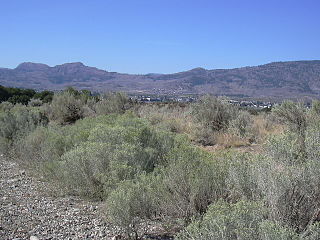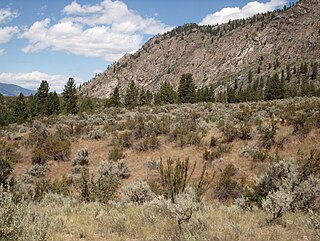Related Research Articles

The Okanagan, also called the Okanagan Valley and sometimes the Okanagan Country, is a region in the Canadian province of British Columbia defined by the basin of Okanagan Lake and the Canadian portion of the Okanagan River. It is part of the Okanagan Country, extending into the United States as Okanogan County in north-central Washington. According to the 2016 Canadian census, the region's population is 362,258. The largest populated cities are Kelowna, Penticton, Vernon, and West Kelowna.

The Okanogan River is a tributary of the Columbia River, approximately 115 mi (185 km) long, in southern British Columbia and north central Washington. It drains a scenic plateau region called the Okanagan Country east of the Cascade Range and north and west of the Columbia, and also the Okanagan region of British Columbia. The Canadian portion of the river has been channelized since the mid-1950s.
The Confederated Tribes of the Colville Reservation is the federally recognized tribe that controls the Colville Indian Reservation, which is located in northeastern Washington, United States. It is the government for its people.

Oliver is a town near the south end of the Okanagan Valley in the Southern Interior of British Columbia, Canada, with a population of nearly 5,000 people. It is located along the Okanagan River by Tuc-el-nuit Lake between Osoyoos and Okanagan Falls, and is labelled as the Wine Capital of Canada by Tourism British Columbia. It was once "The Home of the Cantaloupe" as well as the "Home of the International Horseshow."

The Regional District of Okanagan-Similkameen (RDOS) is in southern British Columbia, adjacent to the U.S. state of Washington. It is bounded by Fraser Valley Regional District to the west, Thompson-Nicola Regional District and Regional District of Central Okanagan to the north, Regional District of Kootenay Boundary to the east, and by Okanogan County, Washington to the south. At the 2011 census the population was 80,742. The district covers a land area of 10,413.44 square kilometres (4,020.65 sq mi). The administrative offices are in the City of Penticton.

Cawston is an unincorporated small community in the south Similkameen Valley, with a 2005 population of 973.

The Sinixt are a First Nations People. The Sinixt are descended from Indigenous peoples who have lived primarily in what are today known as the West Kootenay region of British Columbia in Canada and the adjacent regions of Eastern Washington in the United States for at least 10,000 years. The Sinixt are of Salishan linguistic extraction, and speak their own dialect (snsəlxcín) of the Colville-Okanagan language.
Nicola, also Nkwala or N'kwala, was an important First Nations political figure in the fur trade era of the British Columbia Interior as well as into the colonial period (1858–1871). He was grand chief of the Okanagan people and chief of the Nicola Valley peoples, an alliance of Nlaka'pamux and Okanagans and the surviving Nicola Athapaskans, and also of the Kamloops Band of the Shuswap people.

The Syilx people, also known as the Okanagan, Okanogan or Okinagan people, are a First Nations and Native American people whose traditional territory spans the Canada–US boundary in Washington state and British Columbia in the Okanagan Country region. They are part of the Interior Salish ethnological and linguistic grouping. The Syilx are closely related to the Spokan, Sinixt, Nez Perce, Pend Oreille, Secwepemc and Nlaka'pamux peoples of the same Northwest Plateau region.

The Westbank First Nation is a self-governing First Nations band in the Okanagan region of British Columbia, Canada, and is one of eight bands that comprise the Okanagan Nation Alliance of Syilx people. Westbank First Nation (WFN) is governed by one chief and four councillors, elected every three years by WFN membership. As of April 2019, WFN's membership totaled 914 members, and employs more than 200 people.
The Lower Similkameen Indian Band or Lower Smelqmix, is a First Nations band government in the Canadian province of British Columbia. Their office was in the village of Keremeos in the Similkameen region, until 2015 when they moved into their own $7million multi-purpose facility south of Cawston. They are a member of the Okanagan Nation Alliance.
The Upper Similkameen Indian Band or Upper Smelqmix, is a First Nations band government in the Canadian province of British Columbia, whose head offices are located in town of Hedley in the Similkameen Country. They are a member of the Okanagan Nation Alliance.

The Osoyoos Indian Band is a First Nations government in the Canadian province of British Columbia, located in the town of Oliver and Osoyoos in the Okanagan valley, approximately four kilometres north of the Canada–United States border. They are a member of the Okanagan Nation Alliance. The band controls about 32,000 acres of land in the vicinity of the town of Oliver and Osoyoos.
The Penticton Indian Band is a First Nations government in the Canadian province of British Columbia, located next to the city of Penticton in the Okanagan Valley. They are a member of the Okanagan Nation Alliance. It has an accredited High School.
Okanagan, or Colville-Okanagan, or Nsyilxcən, is a Salish language which arose among the Indigenous peoples of the southern Interior Plateau region based primarily in the Okanagan River Basin and the Columbia River Basin in precolonial times in Canada and the United States. Following British, American, and Canadian colonization during the 1800s and the subsequent assimilation of all Salishan tribes, the use of Colville-Okanagan declined drastically.
The Nicola Athapaskans, also known as the Nicola people or Stuwix, were an Athabascan people who migrated into the Nicola Country of what is now the Southern Interior of British Columbia from the north a few centuries ago but were slowly reduced in number by constant raiding from peoples from outside the valley, with the survivors, the last of whom lived near Nicola Lake, assimilated to the Scw'exmx-Syilx Nicola people by the end of the 19th century. The term Nicola for them is a misnomer, though a common one used by ethnologists and linguists - it commemorates a famous Okanagan chief who once held sway over the valley and its peoples as well as over the Kamloops Shuswap).
The Similkameen Country, also referred to as the Similkameen Valley or Similkameen District, but generally referred to simply as The Similkameen or more archaically, Similkameen, is a region roughly coinciding with the basin of the river of the same name in the Southern Interior of British Columbia. The term "Similkameen District" also refers to the Similkameen Mining District, a defunct government administrative district, which geographically encompasses the same area, and in more casual terms may also refer to the Similkameen electoral district, which was combined with the Grand Forks-Greenwood riding by the time of the 1966 election. The Similkameen Country has deep historical connections to the Boundary Country and the two are sometimes considered one region, partly as a result of the name of the electoral district. It is also sometimes classed as being part of the Okanagan region, which results from shared regional district and other administrative boundaries and names. The term "Similkameen District" may also historically refer to the Similkameen Division Yale Land District, which also includes Osoyoos and the Boundary Country to Osoyoos' east.

The Okanagan Desert is the common name for a semi-arid shrubland located in the southern region of the Okanagan Valley in British Columbia and Washington. It is centred around the city of Osoyoos and is the only semi-arid shrubland in Canada. Part of this ecosystem is referred to as the Nk'mip Desert by the Osoyoos Indian Band, though it is identical to the shrublands elsewhere in the region. To the northwest of this area lies an arid shrubland near Kamloops.
The Colville people, are a Native American people of the Pacific Northwest. The name Colville comes from association with Fort Colville, named after Andrew Colvile of the Hudson's Bay Company. Okanagan: sx̌ʷyʔiɬpx) Earlier, outsiders often called them Scheulpi, Chualpay, or Swhy-ayl-puh; the French traders called them Les Chaudières in reference to Kettle Falls. The neighboring Coeur d'Alene called them Sqhwiyi̱'ɫpmsh and the Spokane knew them as Sxʷyelpetkʷ.

South Okanagan—Similkameen National Park Reserve is a proposed national park reserve located in the Regional District of Okanagan-Similkameen of British Columbia. The goal of the park is to work with the local First Nations to protect a large patch of Okanagan dry forests and part of the northern reach of the Columbia Plateau ecoregion in Canada.
References
- 1 2 3 4 "Syilx Okanagan Nation – Okanagan Nation Alliance" . Retrieved 2022-06-01.
- 1 2 3 4 5 "Timeline – Okanagan Nation Alliance" . Retrieved 2022-06-01.
- 1 2 Christian, Dorothy (31 December 1994). "Crisis averted with Okanagan Nation". News from Indian Country. Hayward, Wisconsin. ProQuest 367674774.
- 1 2 "History & Milestones". UBC's Okanagan Campus. Retrieved 2022-06-01.
- 1 2 "Academics". UBC's Okanagan Campus. Retrieved 2022-06-01.
- 1 2 "Chief Executive Council – Okanagan Nation Alliance" . Retrieved 2022-06-01.
- 1 2 "Syilx Nation Rising! – Okanagan Nation Alliance" . Retrieved 2022-06-01.
- 1 2 Blanchet, Rosanne; Willows, Noreen; Johnson, Suzanne; Batal, Malek; Batal, M (February 2022). "Enhancing cultural food security among the Syilx Okanagan adults with the reintroduction of Okanagan sockeye salmon". Applied Physiology, Nutrition, and Metabolism. 47 (2): 124–133. doi: 10.1139/apnm-2021-0321 . hdl: 1807/109721 . PMID 34807751. S2CID 244489820.
- 1 2 "Okanagan Indian Band". Okanagan Indian Band. Retrieved 2022-06-01.
- 1 2 "Discover WFN - Westbank First Nation". www.wfn.ca. Retrieved 2022-06-01.
- 1 2 "Lower Similkameen Indian Band – Smelqmix" . Retrieved 2022-06-01.
- 1 2 bigbear (2020-10-16). "Upper Similkameen Indian Band (USIB), Hedley BC". Upper Similkameen Indian Band. Retrieved 2022-06-01.
- 1 2 "Home". OIB 2018. Retrieved 2022-06-01.
- 1 2 "Penticton Indian Band" . Retrieved 2022-06-01.
- 1 2 "Upper Nicola Band – Nicola Valley" . Retrieved 2022-06-01.
- 1 2 "Colville Tribes". Colville Tribes. Retrieved 2022-06-01.
- ↑ "Okanagan Nation Declaration".
- ↑ "Okanagan Unity Declaration".
- ↑ "Okanagan Water Declaration".
- ↑ "Syilx Okanagan Language Declaration".
- ↑ "Syilx Child and Family Declaration".